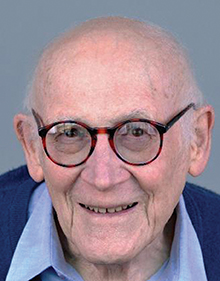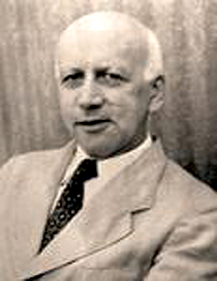Registered with the Registrar of Newspapers for India under R.N.I 53640/91
Vol. XXVI No. 18, January 1-15, 2017
The scientist from Montfort & Madras
by Ullattil Manmadhan (Maddy)
The life of Herbert Claus Friedmann, a German Jew and Indian Citizen for a time, an eminent scientist and professor, a global authority on bacterial enzymes, the biosynthesis of vitamin B12 and texts on the history of biology, begins in the city of Mannheim in southwest Germany, once the home of fine arts and many classical music composers, later a city gobbled up by the Industrial Revolution to become a base for all kinds of large factories, including the one manufacturing Zeppelins. Many Jews lived and once prospered in Mannheim, and the Friedmann family was one among them.
 Dr. Herbert Friedmann.
Dr. Herbert Friedmann.
Herbert was born there in 1927 to Lili, a musician, and Martin Friedmann, a physician who desired to become an ophthalmologist but ended up a dermatologist, after being assigned to care for soldiers suffering from syphilis during the Great War. Life was livable for them until 1938, after which their world was turned upside down by the Nazis.
What started in 1933 as a persecution of sorts, became violence in 1938. On November 9 and 10, 1938, the SS launched Kristallnacht (night of the broken glass) on all Jewish storefronts. The Nazis arrested Martin and transported him to Dachau, the first of the German concentration camps. That same day, a group of men entered and ransacked the family’s apartment, taking away Lili’s violin and Martin’s medical instruments.
In those early days of the -holocaust, Jews were permitted to emigrate overseas if they -“voluntarily” gave up their property and had a valid visa to travel. The Friedmanns had planned to leave and their destination of choice was India. Martin’s friend Ganz taught at the Bombay University and Martin had planned to visit India to study leprosy. It was a visa for that move and that disease which ultimately saved him and his family, as Herbert was to state subsequently.
Lili was quick in action, and applied to the Gestapo at Karlsruhe with Martin’s passport, showing them the life-saving -Indian visa, and, with that, she secured Martin Friedmann’s -release. The family of four, including Herbert’s brother Gerhart, got ready to travel to India. Martin left first, hoping to find a job and a place to live in. He disembarked from his ship at Colombo and travelled to Madras, reaching there in December 1938. Martin, as Herbert -recalls, had stated he was overjoyed by the warmth of not only the tropical city but also the warmth of freedom after the harrowing days in Nazi Germany.
A month later, Lili and the children arrived in Madras. They had a house with a mango tree at the rear. Idu oru nalla pasu (This is a nice cow) was the first sentence that the 12-year-old Herbert Friedmann learned in Tamil when he joined St. Bede’s in 1939. It was all so different from his school in Germany – where he had been wrestling with Latin.
 Dr. Martin Friedmann
Dr. Martin Friedmann
When World War II began in September 1939 there were 550 Germans in Bombay, 195 in Calcutta, and quite a few in other places, totaling around 1500 and including 50 physicians. All the males amongst them, 850 in number, were rounded up, termed as hostile foreigners and interned in Ahmednagar. Martin was one of them.
In Germany, there were some 3,500 British subjects and Germany offered to allow them to depart so long as free departure was provided to Germans interned in India. Some 560, most of the non-Jews, were prepared to return. Parole camps were established for the rest, about 400 in all, in Satara, Nainital, Hazaribagh, Kodaikanal and Yercaud. Martin, Lili, Herbert and Gerhart Friedmann were asked to move with 2 days’ notice to Yercaud in August 1940.
Yercaud in those days was a sleepy little hill town and for the Friedmanns the boondocks. It was to this hamlet that the Friedmanns and other Germans, totaling 98, were sent. The Government had sequestered 23 bungalows for their house arrest. There were two categories of detenus, the Germans under care of the German Government and the German Jews on their own or under care of the Jewish Relief Association (JRA) in Bombay.
The internees were allowed their own furniture, pictures and household items obtained at the expense of the German government or furniture provided by the Indian government. Families with children were accommodated in a bungalow, while two childless families or 3 or 4 individuals had to share a house.
A modest monthly allowance of Rs. 120 per married couple, Rs. 30 per child and Rs. 70 for individuals was paid by the Indian Government. Those who had savings were allowed to employ servants. They were not allowed to leave their houses between eight in the evening and six in the morning, but otherwise they were free to move around Yercaud, though not beyond. Schoolgoing children were enrolled in Monfort (boys) and Sacred Heart (girls). The Friedmann brothers joined Montfort. A small hospital was available but more severe cases were treated in Salem. German doctors who were interned were allowed to practice.
The non-Jews received financial support from the German Reich through the Swiss consul, jews got a little help from the JRA. The Friedmanns managed to employ a cook, but their house had neither a toilet nor running water. The water had to be drawn from a well and boiled before they could drink it.
Martin Friedmann treated other prisoners for a small fee to keep the family going. After the War, he decided to stay on in Yercaud. He treated the workers on the coffee plantations suffering from malaria, tuberculosis, or parasites. However, as many of the poor plantation workers were not able to pay fees, he had to be happy with gifts such as jackfruit. Martin Friedmann thus earned very little – less than Rs. 4,000 a year. The family received a monthly support of Rs. 150 (from 1945 onwards) from the Jewish Relief Association. They could not even afford a refrigerator and used to store precious penicillin at a planter friend’s estate some 5 miles away.
Martin continued with his research in various fields of tropical medicine, presenting papers on ophthalmology as well as several papers covering dermatology, parasitology, human metabolism and malaria, while at Yercaud. Herbert, meantime passed out (in 1944) from Monfort with multiple distinctions, second only to one Chengappa. On the final day at school, his principal treated him to his first cigarette, to celebrate his ceremonial passing into manhood. He then joined Madras Christian College for his Bachelor’s degree.
He later moved to Madras Medical College where he never felt discriminated against. He then went on to complete his post-graduation at Madras University. He submitted valuable papers while at MMC’s biochemistry department, which can still be viewed in their records (‘Method to diminish pigments secreted from urine’, August 1952).
Meanwhile, Martin Fried-mann’s difficult financial situation worsened in the spring of 1953, when he became seriously ill. In May 1953, he submitted an application for support payment to the Federal Consul General in Bombay, and the Friedmanns received about DM 440 from the Consulate monthly from June 1953. But his health continued to deteriorate. He was moved to CMC Vellore for treatment but succumbed to a heart attack in August 28, 1953 and was buried in the Vellore cemetery. In May 1954, the Friedmanns received DM 12,600 from Germany as reparation for losses suffered.
It was at this juncture that Herbert Friedmann was contacted in Madras by the very same man who helped his father immigrate to India, Dr. Ganz, who had by then become the Chancellor of the University of Frankfurt. He helped Herbert get a fellowship for a PhD course at the University of Chicago.
With that, and the new fortune, the family decided to make North America their home and they sailed out of India (Lili moved to British Columbia, Canada, with Gerhart and passed away in 1973.) The family traveled as Indian citizens.
Herbert completed his doctorate at the University of Chicago in 1958. Some years after arrival, he also acquired American citizenship. He worked in Chicago as a research associate, then moved to Baltimore to complete a two-year fellowship at Johns Hopkins University, where he met his future wife, Joan Bowerman. In 1960, he returned to Chicago as an assistant professor in physiology and began his extensive studies of vitamin B12 and its role in bacterial nucleotide synthesis. He was to spend the rest of his life researching and teaching and became a favourite among students for his exceptional undergraduate teaching abilities. He won for this in 1978 the coveted Llewellyn John and Harriet Manchester Quantrell Award for Excellence.
His ‘56 Teaching Laws’, something oft quoted by all and sundry is what any aspiring teacher should keep close to their heart or by their bedside. His books on enzymes are studied by many a medical student. He passed away in January, 2014.
Gerhart followed Herbert’s footsteps. He too obtained a B.Sc. and an M.A. from Madras University, worked briefly with the Tata Institute of Fundamental Research, Bombay, and obtained a Ph.D. from the University of British Columbia (working with the Raman Effect!). He taught Physics at the University of Victoria in Canada from 1958 to 1990 and was a keen chess player. He passed away in 1990 and is remembered through a bursary for aspiring scholars, awarded in his name, annually.
3 of the ‘56 Laws of Teaching’
Here are a few extracts from Herbert’s ‘56 Laws of Teaching’
Never snow a student under, with an exhibition of your erudition: a student is far less interested in what you know than in what he or she can learn.
Look at the students when you lecture; the ceiling and the floor are not interested, and neither is the blackboard.
Never expect your students to learn or to understand anything that you cannot or did not learn or understand yourself.

